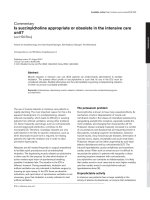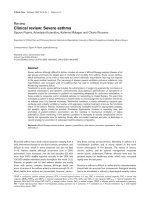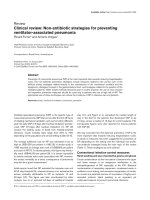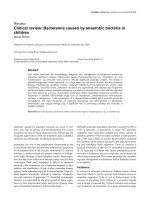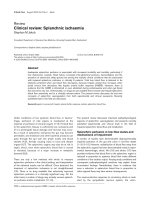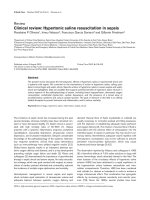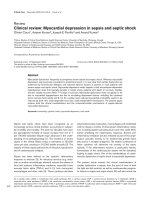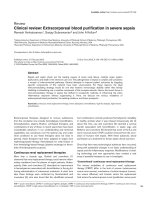Báo cáo y học: "Clinical review: Acid–base abnormalities in the intensive care unit" doc
Bạn đang xem bản rút gọn của tài liệu. Xem và tải ngay bản đầy đủ của tài liệu tại đây (110.61 KB, 6 trang )
198
A
TOT
= sum of weak acids and proteins in human plasma; ICU = intensive care unit; IL = interleukin; LR = lactated Ringer’s; pCO
2
= Partial pres-
sure of carbon dioxide in arterial blood; SBE = standard base excess; SID = strong ion difference; SIDe = effective strong ion difference; SIG =
strong ion gap.
Critical Care April 2005 Vol 9 No 2 Kaplan and Frangos
Abstract
Acid–base abnormalities are common in the critically ill. The
traditional classification of acid–base abnormalities and a modern
physico-chemical method of categorizing them will be explored.
Specific disorders relating to mortality prediction in the intensive
care unit are examined in detail. Lactic acidosis, base excess, and
a strong ion gap are highlighted as markers for increased risk of
death.
Introduction
Deranged acid–base physiology drives admission to a critical
care arena for vast numbers of patients. Management of
diverse disorders ranging from diabetic ketoacidosis to hypo-
perfusion with lactic acidosis from hemorrhagic or septic
shock shares a variety of common therapies for disordered
acid–base balance. It is encumbent upon the intensivist to
decode the deranged physiology and to categorize the
disorder in a meaningful fashion to direct effective repair
strategies [1].
Besides the traditional classification of respiratory versus
metabolic, acidosis versus alkalosis, and gap versus nongap
(normal gap), the intensivist benefits from classifying acid–
base disorders into three discrete groups: iatrogenically
induced (i.e. hyperchloremic metabolic acidosis), a fixed
feature of a pre-existing disease process (i.e. chronic renal
failure, hyperlactatemia), or a labile feature of an evolving
disease process (i.e. lactic acidosis from hemorrhage, shock
of any cause). The therapy for, and the outcome from, each of
these three categories may be distinctly different. A review of
the genesis of acid–base abnormalities is appropriate but will
be limited to metabolic derangements, as respiratory acid–
base abnormalities are usually reparable with adjustments in
sedative or ventilator prescription.
Acid–base abnormality genesis
Traditional paradigms of acid–base abnormalities hinge on
generation of protons from the liberation of metabolic acids
such as lactate or carbonic acid from increased CO
2
. Most
traditional views rely on the Henderson–Hasselbach equation
to determine the pH and proton concentration. Other
attempts at classification rely upon nomograms with
imprecise ‘grey zones’ to account for the imprecision in the
Henderson–Hasselbach equation solutions. The key fault
with these determinations is reliance upon bicarbonate as a
determinant of the pH. In 1983, Peter Stewart clarified the
physical chemistry principles that describe the independent
determinants of proton concentration and pH, allowing the
clinician to precisely and accurately determine the pH and to
understand the genesis of each acid–base disturbance
encountered [2].
The Stewartian methodology relies upon the relationships
between ions that completely dissociate at physiologic pH —
so-called ‘strong ions’. There exist strong cations (Na
+
, K
+
,
Ca
2+
and Mg
2+
) as well as strong anions (Cl
–
, lactate, and
sulphates [most notable in renal failure]). These strong ions
establish a readily apparent strong ion difference (SID) that is
net strong ion-positive (normal approximately +40). Since
human acid–base physiology derives its homeostasis from
charge balance, according to the physical chemistry
principles articulated by Stewart the SID must be
counterbalanced by an equal and opposing charge termed
the effective strong ion difference (SIDe) (normal
approximately –40). The SIDe negative charge principally
stems from the dissociated moieties of plasma proteins
(~78% albumin) and phosphate (~20%). The sum of these
weak acids is known as A
TOT
since they exist in a dissociated
form (A
–
) as well as an associated form (AH). When the SID
Review
Clinical review: Acid–base abnormalities in the intensive care
unit
Lewis J Kaplan and Spiros Frangos
Yale University School of Medicine, Department of Surgery, Section of Trauma, Surgical Critical Care and Surgical Emergencies, New Haven,
Connecticut, USA
Corresponding author: Lewis J Kaplan,
Published online: 20 October 2004 Critical Care 2005, 9:198-203 (DOI 10.1186/cc2912)
This article is online at />© 2004 BioMed Central Ltd
199
Available online />and SIDe are equal, the plasma pH is exactly 7.4 at a pCO
2
of 40 torr. These relationships are demonstrated in Fig. 1.
Note that when the SID and SIDe are unequal, the difference
between the two is termed the strong ion gap (SIG) (SID – SIDe,
normal = 0). This value is not discoverable by interrogation of
any other acid–base variables or scheme, and is buried within
the anion gap along with A
–
and lactate. It is important to note
that the generation or consumption of protons is driven by the
law of mass action upon the relationships identified in Fig. 2.
Saline is comprised of equal parts of sodium and chloride,
and as such appears electrically neutral. When equal
amounts of sodium and chloride are added to plasma,
however, the effects are different from those expected. The
plasma chloride level is less than that of sodium. The net
impact of adding equal amounts of sodium and chloride will
therefore raise the chloride to a greater degree than the
sodium. This results in a narrowed SID and a reduced plasma
positive net strong ion charge. When plasma positive charge
is reduced, as commonly occurs with significant chloride
loading (reduced SID), an immediate and compensatory
response is proton generation to aid in restoring charge
equilibrium. The clinician identifies this physiologic process
as a decreased pH. The genesis of hyperchloremic metabolic
acidosis is thus readily understandable based on the Stewart
principles [3]. It is important to recognize that the changes in
plasma electrolyte concentration are millimolar in scale while
the corresponding changes in proton concentration are
nanomolar. There is therefore an unfavorable electrochemical
gradient for simple plasma electrolyte and proton ‘exchange’;
the mechanism that underpins these changes is well explained
by Stewart [2].
Relatedly, an individual with chloride loss (vomiting, large
volume nasogastric losses without proton pump blockade)
would have a net increase in plasma positive charge. Exactly
the opposite process occurs to consume protons, leading to
an increased pH. Importantly, this clinical condition highlights
the mechanism underlying hypochloremic metabolic alkalosis
as well as the rationale behind chloride loading for repair —
the Cl
–
therapeutically reduces the plasma excess positive
charge and the proton concentration in tandem. This process
is unassociated with mortality, reflects the common use of
loop diuretics for volume management, and will not be further
explored
A central tenet of the Stewart methodology identifies the
three independent control mechanisms for pH: SID, pCO
2
and A
TOT
. Bicarbonate is a dependent variable, and as such
does not determine the pH. This key concept aids in
constructing acid–base repair strategies in the critical care
environment. By way of example, patients with hyper-
chloremic metabolic acidosis may be corrected by altering
their intravenous fluid prescription. An ideal strategy reduces
plasma Cl
–
while preserving plasma Na
+
. This may be
achieved by prescribing D
5
W plus a variable amount of
NaHCO
3
as the maintenance fluid, with the amount of
NaHCO
3
dependent on the desired amount of Cl
–
and pH
change. This prescription provides a strong cation (Na
+
)
without a strong anion, resulting in an expected increase in
SID as Na
+
is maintained but Cl
–
falls; the increased SID
drives proton consumption and produces an increased pH.
Importantly, only changes in strong ions drive changes in
proton concentration. There are, however, readily identifiable
and compensatory changes in dependent ions such as
bicarbonate. Understanding the physiologic mechanisms
underpinning acid–base abnormalities thus provides a
rationale for therapeutic intervention. Indeed, a recent
comparison of traditional methods of acid–base interpretation
Figure 1
Charge balance in human plasma. SIDa, apparent strong ion
difference; SIDe, effective strong ion difference; SIG, strong ion gap.
Reproduced with permission from [1].
Figure 2
Charge interaction in human plasma. The equations demonstrate the
charge interactions in human plasma that serve as independent control
mechanisms for pH determination (pCO
2
, sum of weak acids and
proteins in human plasma [A
TOT
], and strong ion difference).
pCO
2
H
2
O + CO
2
↔ H
2
CO
3
↔ H
+
+ HCO
3
–
Weak acids/proteins
A
TOT
↔ A
–
+ AH
Strong ion difference
(Na
+
+ K
+
+ Mg
2+
+ Ca
2+
) – (Cl
–
+ lactate)
200
Critical Care April 2005 Vol 9 No 2 Kaplan and Frangos
to guide therapy with Stewart’s physical–chemical method
has championed the latter as an ideal means of determining
the mechanism, and of uncovering acid–base abnormalities
that were unappreciated using traditional classification and
interpretation schemes [4].
Lactic acidosis and hyperlactatemia
The most common acid–base abnormality in trauma patients
is lactic acidosis from hypovolemic shock and hypoperfusion.
Lactic acidosis is a gap metabolic acidosis that is a labile
feature of an evolving disease process. As such, lactic
acidosis is a final common feature of a variety of processes
that engender hypoperfusion, including diabetic ketoacidosis,
septic shock, cardiogenic shock, and a variety of intoxica-
tions. These entities will therefore not be discussed separately;
the discussion will instead focus on the consequences and
implications of lactic acidosis regardless of etiology.
Lactate generated from hypoperfusion generates acidosis as
the vast amount of lactate produced contributes a strong
anion, decreases the SID, and generates protons. In contrast,
lactate from lactated Ringer’s (LR) solution is in small
quantities (28 mmol/l) and is readily consumed, leaving
behind Na
+
as a strong cation; alkalinization results from the
more positive SID leading to proton consumption.
Resolution of lactic acidosis correlates well with survival in a
time-dependent fashion [5]. Moreover, resolving occult
hypoperfusion (normal vital signs, but a persistent lactic
acidosis) directly relates to infection risk as well as to
mortality [6,7]. Reduced infectious events (principally
respiratory complications) were realized using a protocol to
clear lactate, whether overt or occult, as an arbiter of
underlying hypoperfusion and systemic infection risk.
In order to avoid inappropriate therapy, it is important to
differentiate lactic acidemia from hyperlactatemia (normal pH,
elevated lactate level, constant lactate/pyruvate ratio). The
former indicates a condition that merits therapy (volume
expansion, inotropic support, septic source control), while
hyperlactatemia frequently stems from exogenous medications,
or as an endogenous accompaniment to persistently elevated
endogenous catecholamines after shock or trauma [8].
Lactic acidosis has long been utilized as an outcome
predictor with regard to survival after trauma, both blunt and
penetrating, as well as intra-abdominal catastrophe [5–7,9,
10]. However, lactate also performs quite well in the intensive
care unit (ICU) as a mortality gauge [11]. The presence of
this potent predictor of outcome is readily identifiable in the
ICU setting with physical examination using extremity
temperature as an arbiter (exclusive of patients with
peripheral occlusive vascular disease) [12].
Lactic acidosis, but not hyperlactatemia [13], closely
correlates with mortality risk and serves as a window into cell-
level oxygen-dependent processes. Moreover, clearance of
lactic acidemia portends an excellent likelihood of survival. In
one convenience sampling of surgical ICU patients (general
surgery and trauma) comparing lactate and base excess,
lactate appears superior in predicting mortality and morbidity
[14]. Relatedly, a separate study (prospective, consecutive,
mixed medical–surgical patients) found that the combination
of the two variables appeared superior to either lactate or
base excess alone in predicting survival [15].
Standard base excess (base deficit)
A companion acid–base variable, base excess (commonly
presented as base deficit) has also been touted as a
prognostic variable in assessing outcome in the critically ill.
Base excess indicates metabolic acidosis or alkalosis, but
does not help place the acidosis into one or another category
with regard to genesis. It is, however, commonly and readily
assessed and is therefore the focus of a host of studies. A
plethora of studies present a mixed picture in the analysis of
base excess since the data derive from two distinct time
frames: Emergency Department arrival versus some time after
resuscitation. It is in the interpretation of base excess that the
Stewart principles are vital to guide interpretation. Indeed, it
has been demonstrated that the base excess may be
manipulated by fluid resuscitation. Generating a hyper-
chloremic metabolic acidosis will create a spuriously more
negative base deficit (or increased base excess) as the Cl
–
decreases the pH unaccompanied by hypoperfusion and
lactic acidemia [16]. Prognostication dependent on post-
resuscitation standard base excess (SBE) values must
therefore be interpreted with caution.
Nonetheless, presentation or pre-resuscitation base excess
values reliably indicate the degree of acid production
following injury [17]. Interestingly, in this large cohort analysis
of presentation SBE, the 50% lethal dose for the acid load
indicated by base deficit shifted to a substantially lower level
for a given age when combined with a traumatic brain injury; it
is unknown whether this is true for other injuries in isolation or
combination. The interpretation of SBE must therefore
incorporate the injury complex into decision-making, perhaps
limiting its utility. A recent study of salvageable trauma
patients who underwent arterial blood gas analysis identified
that SBE utility was greatest in predicting the outcome of
patients sustaining gunshot wounds and blunt injury versus
those with stab wounds or lacerations [18]. Mortality was
lower for stab/laceration patients at any given base deficit,
rendering interpretation in this subgroup problematic. Similar
to lactate, the rate of clearance of base deficit to normal,
rather than the absolute value, correlates better with survival
than do changes in pH [19].
It is important to note that, using an ex vivo model, base
excess values are CO
2
invariate (unlike pH), potentially aiding
in their initial utility and interpretation [20]. However, the
clinical milieu includes multiple elements that may impact
201
base excess, rendering the CO
2
–base excess relationship
difficult to appreciate. Nonetheless, base excess correlates
with transfusion requirements and with length of stay [21].
In patients with major hepatic trauma, base deficit (50% lethal
dose, –11.8 mmol/l) and 24-hour transfusion requirement
(50% lethal dose, 5.4 l packed red blood cells) surfaced as the
strongest predictors of the risk of death, outperforming arterial
lactate [22]. Importantly, these observations and the model
were then tested on a different cohort with only pelvic
fractures, with excellent performance. Smaller studies in
pediatric trauma patients found that a base deficit less negative
than –5 predicted uniform survival since all study group deaths
occurred in patients with more negative base deficit values
[23]. It thus appears that pre-resuscitation base excess or
deficit correlates with survival and serves as another indicator
of an underlying disease (hypoperfusion), but interpretation
must be tempered by age and the mechanism of injury.
Hyperchloremic acidosis
While we touched upon hyperchloremic acidosis earlier, this
common iatrogenically induced entity deserves further
exploration. As already noted, the genesis of hyperchloremic
metabolic acidosis stems from excess chloride administration
relative to sodium, commonly as 0.9% normal saline solution,
0.45% normal saline solution, and even LR solution in large
quantities [24–26]. This entity is thus an iatrogenic metabolic
acidosis of the nongap variety. Hyperchloremia has been
identified in up to 80% of patients admitted to a mixed
medical–surgical ICU [26]. While not a predictor of outcome,
hyperchloremic metabolic acidosis may contribute to
morbidity and resource utilization. ICU admission for an
‘unexpected acidosis’, increased and perhaps mechanically
supported minute ventilation to compensate for acidosis, and
more complex intravenous fluid prescriptions (especially
when utilizing hyperalimentation for nutritional support) are
but a few ICU care elements impacted by hyperchloremic
metabolic acidosis. While these events are probably
insignificant for the young and otherwise physiologically
sound patients, they may be significantly physiologically
challenging for the elderly or for those with physiologic
decompensation following significant trauma and hemor-
rhagic or septic shock.
The relationship between hyperchloremia and renal
dysfunction is well known [27,28]. Moreover, ICU survival has
been linked to Acute Pathophysiology and Chronic Health
Evaluation II/III scores and multiple organ dysfunction
syndrome, of which acute renal failure is a major element
[29]. Controversy has long surrounded whether patients die
from their renal failure or whether they die from the disease
process. Recent data strongly suggest that acute renal failure
is an independent risk factor for death despite renal
replacement therapy [30]. In this study of acute renal failure,
patients requiring renal replacement therapy suffered an
accelerated mortality (62.8%) compared with those without
renal failure (15.6%). The mortality differences remained
unexplained by differences in the severity of illness, thus
helping establish acute renal failure as an independent risk
factor for mortality. Moreover, complicated acidosis/alkalosis
was independently associated with death.
The deleterious impact of acute renal failure is thus potentially
minimized by avoiding iatrogenic hyperchloremia and its
attendant compromise of renal function. Further studies are
needed to ascertain the impact of this entity upon current
arbiters of morbidity including the ICU length of stay,
ventilator days, acute lung injury/acute respiratory distress
syndrome, and ventilator-associated pneumonia. Moreover,
virtually no research addresses hyperchloremia avoidance
strategies and their impact on morbidity such as acute renal
failure in at-risk populations, nor addresses mortality.
Both animal and human data identify a linearly decreased pH
and an increased SID with progressive chloride loading
[31–33]. Interestingly, metabolic acidosis induced by
chloride from normal saline solution loading is associated
with impaired coagulation and the need for bicarbonate
buffering of the induced acidosis, while resuscitation with
comparable amounts of LR solution required no such therapy
[31,33]. Hyperchloremic acidosis, while not a predictor of
outcome, may therefore serve as a sentinel for hemorrhage
risk, for component transfusion therapy, and for accelerated
resource utilization. Importantly, one ex vivo study noted the
induction of a SIG with crystalloid-induced hyperchloremic
acidosis; no SIG was induced by adding comparable
amounts of large molecular weight hydroxyethyl starch [31].
In a related provocative study, sepsis survival was enhanced
by resuscitation with a large molecular weight hydroxyethyl
starch molecule suspended in a balanced salt solution
compared with LR solution or saline, and was unassociated
with hyperchloremic metabolic acidosis [34].
Immune effects of acidosis
The effects of metabolic acidosis span more than one system.
Immune activation has been intimately linked to the presence
of acidosis, and SIG generation may be but one feature.
Crystalloid resuscitation serves as a potent trigger for human
white blood cell count activation, manifested as an oxidative
burst and the expression of cell surface adhesion molecules
[35]. Activation of T-cell protein kinases has been demon-
strated with hypertonic saline, an effect whose downstream
cell-specific responses carry an uncertain significance [36].
More certainly, intravascular acid infusion reliably creates
acute lung injury and increases exhaled nitric oxide
concentration in a rat model [37]. This effect has been
demonstrated to stem from acidosis-stimulated expression of
inducible nitric oxide synthase, and was associated with
elaboration of the proinflammatory cytokine IL-6, also in a rat
preparation [38]. Importantly, this work suggests that
correction of acidosis may ameliorate inducible nitric oxide
synthase expression and reduce lung injury.
Available online />202
Relatedly, acidosis included by lactate, pyruvate or HCl has
been recently demonstrated to increase whole blood
viscosity at both high and low shear rates of flow. During
acidosis induction, hematocrit increases reflecting red blood
cell swelling were also observed. Most importantly, these
rheologic changes were reversible with the correction of
acidosis. These data lend support to the notion that
correcting acidosis represents more than ‘treating numbers’
and instead addresses important cellular and subcellular
events. It is possible that the increased viscosity and
hematocrit is responsible, in part, for regional hypoperfusion
despite normal or supranormal systemic flow. Clearly further
study is warranted, but one must consider that the time-
honored endpoint of mortality is not well suited to assess the
interventions targeting acid–base balance. Measures of
morbidity or resource utilization may be more appropriate
instead.
Strong ion gap
There are several studies that either support [39,40] or decry
the utility of the Stewart methodology in evaluating ICU
patients [26,41,42]. The SIG, as determined by Stewart’s
physico-chemical method, is strongly associated with
metabolic acidosis, but is an independent entity that is
probably a labile feature of an evolving disease process. One
element that has surfaced from these studies is that the
Stewart methodology is a precise and readily utilizable means
of identifying the nature of the metabolic aberration; a
calculator to determine the individual components is
downloadable from the Internet [43]. How may one resolve
the seeming disparity of SIG utility identified in some studies
that is conspicuously lacking in others? The answer may be
found in the timing. Much like base excess, the value of the
SIG may be related to the time of assay. Since the natural
history of the SIG and its clearance value remains unknown
(similar to the early lactate observations), we must look to
pre-resuscitation SIG analysis as a more controlled evaluation
scheme.
In patients with major vascular injury requiring operative
repair, but prior to resuscitation, an increased SIG (> 5) is
predictive of mortality [44]. Performance characteristics
based on receiver–operator characteristic curve analysis
indicated a SIG area of 0.991 for mortality (95% confidence
interval, 0.972–0.998) and that for anion gap of 0.994 (95%
confidence interval, 0.976–0.999), outperforming lactate
(receiver–operator characteristic curve area, 0.981; 95%
confidence interval, 0.957–0.993). Multivariate logistic
regression analysis indicated that an increased SIG (odds
ratio, 3.6; 95% confidence interval, 1.99–6.78), more
strongly than injury severity score (odds ratio, 1.17; 95%
confidence interval, 1.06–1.31), was predictive of mortality.
In a related study in unselected trauma patients, the SIG
discriminated quite well between survivors and those who
died within 72 hours of Emergency Department arrival, again
outperforming lactate and base deficit [45]]. While the
absolute SIG levels were not identical, the import behind the
elevated level remains unaltered. It may be that the degree of
SIG elevation is disease specific. An increased SIG occurs in
patients with hepatic dysfunction [46] and renal dysfunction
[26], as well as during endotoxin-induced sepsis [47]. In a
large retrospective database analysis of patients requiring
ICU care, SIG > 2 was independently linked with mortality in
patients evidencing metabolic acidosis [48].
Based on these studies, longitudinal assessments of changes
in the SIG as a predictor of outcome are underway. Nonethe-
less, it seems prudent to incorporate the pre-resuscitation
SIG into the mélange of information that guides outcome
prognostication. These data may be incorporated into daily
practice using a handheld calculator, or a computer-based
macro utilizing the relevant data points from the clinical
laboratory; automated abstraction is ideal but awaits the
development of appropriate interfaces with existing laboratory
devices. It is essential to note that no evaluation method
besides the physico-chemical one of Stewart allows the
clinician to ascertain the presence and magnitude of the SIG.
Conclusion
Traditional classification schemes of acid–base derange-
ments are too broad to aid in prognostication. Individual
acid–base element evaluation allows one to draw valid
conclusions regarding the likelihood of survival. The Stewart
physico-chemical approach to acid–base analysis readily
lends itself to these determinations by precisely evaluating
the independent determinants of pH as well as the important
SIG. At present, lactate, pre-resuscitation base deficit and
the SIG appear most predictive of outcome in the critically ill,
and they should be incorporated into a prognostication
method. Future studies of acid–base prediction of outcome
should strongly consider including each of these variables in their
methodology. Further evaluation of these and potentially other
markers of morbidity and resource utilization is appropriate.
Competing interests
The author(s) declare that they have no competing interests.
References
1. Gunnerson K, Kellum JA: Acid–base and electrolyte analysis in
critically ill patients: are we ready for the new millennium?
Curr Opin Crit Care 2003, 9:468-473.
2. Stewart PA: Modern quantitative acid–base chemistry. Can J
Physiol Pharm 1983, 61:1444-1461.
3. Miller L, Waters JH: Mechanism of hyperchloremic nonanion
gap acidosis. Anesthesiology 1997; 87:1009-1010.
4. Fencl V, Jabor A, Kazda A, Figge J: Diagnosis of metabolic
acid–base disturbances in critically ill patients. Am J Respir
Crit Care Med 2000, 162:2246-2251.
5. Abramson D, Scalea TM, Hitchcock R, Trooskin SZ, Henry SM,
Greenspan J: Lactate clearance and survival following injury. J
Trauma 1993, 35:584-589.
6. Claridge JA, Crabtree TD, Pelletier SJ, Butler K, Sawyer RG,
Young JS: Persistent occult hypoperfusion is associated with
a significant increase in infection rate and mortality in major
trauma patients. J Trauma 2000, 48:8-14.
Critical Care April 2005 Vol 9 No 2 Kaplan and Frangos
203
Available online />7. Blow O, Magliore L, Claridge JA, Butler K, Young JS: The golden
hour and the silver day: detection and correction of occult
hypoperfusion within 24 hours improves outcomes from
major trauma. J Trauma 1999, 47:964-969.
8. James JH, Luchette FA, McCarter FD, Fischer JE: Lactate is an
unreliable indicator of tissue hypoxia in injury or sepsis.
Lancet 1999, 354:505-508.
9. Jeng JC, Jablonski K, Bridgeman A, Jordan MH: Serum lactate,
not base deficit, rapidly predicts survival after major burns.
Burns 2002, 28:161-166.
10. Mikulaschek A, Henry SM, Donovan R, Scalea TM: Serum lactate
in not predicted by anion gap or base excess after trauma
resuscitation. J Trauma 1996, 40:218-224.
11. Mizock BM, Falk JL: Lactic acidosis in critical illness. Crit Care
Med 1992, 20:80-93.
12. Kaplan L, McPartland K, Santora TA, Trooskin SZ: Start with the
physical examination to identify hypoperfusion in ICU
patients. J Trauma 2001, 50:620-628.
13. Mizock BM: Significance of hyperlactatemia without acidosis
during hypermetabloic stress. Crit Care Med 1997, 25:1780-
1781.
14. Husain FA, Martin MJ, Mullenix PS, Steele SR, Elliott DC: Serum
lactate and base deficit as predictor of mortality and morbid-
ity. Am J Surg 2003, 185:485-491.
15. Smith I, Kumar P, Molloy S, Rhodes A, Newman PJ, Grounds RM,
Bennett ED: Base excess and lactate as prognostic indicators
for patients admitted to intensive care. Int Care Med 2001,
27:74-83.
16. Brill SA, Stewart TR, Brundage SI, Schreiber MA: Base deficit
does not predict mortality when secondary to hyperchloremic
acidosis. Shock 2002, 17:459-462.
17. Rutherford E, Morris JA, Reed GW, Hall KS: Base deficit strati-
fies mortality and determines therapy. J Trauma 1992, 33:417-
423.
18. Tremblay L, Feliciano DV, Rozycki G: Assessment of initial base
deficit as a predictor of outcome: mechanism of injury does
make a difference. Am Surg 2002, 68:689-693.
19. Davis J, Kaups KL, Parks SN: Base deficit is superior to pH in
evaluating clearance of acidosis after traumatic shock.
J Trauma 1998, 44:114-118.
20. Morgan TJ, Clark C, Endre Z: Accuracy of base excess — an in
vitro evaluation of the Van Slyke equation. Crit Care Med
2000, 28:2932-2936.
21. Davis JW, Parks SN, Kaups KL, Gladen HE, O'Donnell-Nicol S:
Admission base deficit predicts transfusion requirements and
risk of complications. J Trauma 1996, 41:769-774.
22. Siegel JH, Rivkind AI, Dalal S, Godzari S: Early physiologic pre-
dictors of injury severity and death in blunt multiple trauma.
Arch Surg 1990, 125:498-508.
23. Randolph LC, Takacs M, Davis KA: Resuscitation in the pedi-
atric trauma population: admission base deficit remains an
important prognostic indicator. J Trauma 2002, 53:838-842.
24. Scheingraber S, Rehm M, Sehmisch C, Finsterer U: Rapid saline
infusion produces hyperchloremic acidosis in patients under-
going gynecologic surgery. Anesthesiology 1999, 90:1265-1270.
25. Hayhoe M, Bellomo R, Liu G, McNicol L, Buxton B: The aetiology
and pathogenesis of cardiopulmonary bypass-associated
metabolic acidosis using polygeline pump prime. Int Care
Med 1999, 25:680-685.
26. Moviat M, van Haren F, van der Hoeven H: Conventional or
physicochemical approach in intensive care unit patients with
metabolic acidosis. Crit Care 2003, 7:R41-R45.
27. Wilcox CS: Regulation of renal blood flow by plasma chloride.
J Clin Invest 1983, 71:726-735.
28. Williams EL, Hildebrand KL, McCormick SA, Bedel MJ: The
effect of intravenous lactated ringer’s solution versus 0.9%
sodium chloride solution on serum osmolality in human vol-
unteers. Anesth Analg 1999, 88:999-1003.
29. Barie P, Hydo LJ, Fischer E: Utility of severity scoring for pre-
diction of prolonged critical care. J Trauma 1996, 40:513-519.
30. Metnitz PG, Krenn CG, Steltzer H, Lang T, Ploder J, Lenz K, Le
Gall JR, Druml W: Effect of renal failure requiring renal
replacement therapy on outcome in critically ill patients. Crit
Care Med 2002, 30:2051-2058.
31. Patterson T, Bailey H, Kaplan LJ: Hyperchloremia induces aci-
dosis, increases the strong ion gap, and impairs coagulation
[abstract]. Crit Care Med 2000, Suppl 28:A118.
32. Healey, MA, Davis RE, Liu FC, Loomis WH, Hoyt DB: Lactated
ringers in superior to normal saline in a model of massive
hemorrhage and resuscitation. J Trauma 1998, 45:894-899.
33. Waters JH, Gottlieb A, Schoenwald P, Popovich MJ, Sprung J,
Nelson DR: Normal saline versus lactated ringer’s solution for
intraoperative fluid management in patients undergoing
abdominal aortic aneurysm repair: an outcome study. Anesth
Analg 2001, 93:817-822.
34. Kellum JA: Fluid resuscitation and hyperchloremic acidosis in
experimental sepsis: improved short-term survival and
acid–base balance with Hextend compared with saline. Crit
Care Med 2002, 30:300-305.
35. Rhee P, Wang D, Ruff P, Austin B, DeBraux S, Wolcott K, Burris
D, Ling G, Sun L: Human neutrophil activation and increased
adhesion by various resuscitation fluids. Crit Care Med 2000,
28:74-78.
36. Junger WG, Hoyt DB, Hamreus M, Liu FC, Herdon-Remelius C,
Junger W, Altman A: Hypertonic saline activates protein
kinases and mitogen-activated protein kinase p38 in T-cells. J
Trauma 1997, 42:437-443.
37. Pedoto A, Caruso JE, Nandi J, Oler A, Hoffmann SP, Tassiopoulos
AK, McGraw DJ, Camporesi EM, Hakim TS: Acidosis stimulates
nitric oxide production and lung damage in rats. Am J Respir
Crit Care Med 1999, 159:397-402.
38. Haque IU, Huang CJ, Scumpia PO, Nasiroglu O, Skimming JW:
Intravascular infusion of acid promotes intrapulmonary
inducible nitric oxide synthase activity and impairs blood oxy-
genation in rats. Crit Care Med 2003, 31:1454-1460.
39. Kellum JA: Metabolic acidosis in the critically ill: lessons
learned from physical chemistry. Kidney Int 1998, 53 (Suppl
66):S81-S86.
40. Balasubramanyan N, Havens PL, Hoffman GM: Unmeasured
anions identified by the Fencl–Stewart method predict mortal-
ity better than base excess, anion gap, and lactate in patients
admitted in the pediatric intensive care unit. Crit Care Med
1999, 27:1577-1581.
41. Hatherill M, Waggie Z, Purves L, Reynolds L, Argent A: Mortality
and the nature of metabolic acidosis in children with shock.
Int Care Med 2003, 29:286-291.
42. Cusack RJ, Rhodes A, Lochhead P, Jordan B, Perry S, Ball JA,
Grounds RM, Bennett ED: The strong ion gap does not have
prognostic value in critically ill patients in a mixed
medical/surgical adult ICU. Int Care Med 2002, 28:864-869.
43. Kellum JA (Ed): The Acid Base pHorum [c.
edu/education/resources/phorum.html], accessed 10 December
2003.
44. Kaplan LJ, Kellum JA: Initial pH, base deficit, lactate, anion gap,
strong ion difference and strong ion gap predicts outcome
from major vascular injury. Crit Care Med 2004, 32:1120-
1124.
45. Kaplan LJ, Bailey H, Klein A, et al.: Strong ion gap: a predictor of
early mortality following blunt or penetrating trauma
[abstract]. Crit Care Med 1999, Suppl 27:A42.
46. Kellum JA, Kramer DJ, Pinsky MR: Strong ion gap: a methodol-
ogy for exploring unexplained anions. J Crit Care 1995, 10:51-
55.
47. Kellum JA, Bellomo R, Kramer DJ, Pinsky MR: Hepatic anion flux
during acute endotoxemia. J Appl Physiol 1995, 78:2212-
2217.
48. Gunnerson KJ, Saul M, Kellum JA: Lactic versus nonlactic meta-
bolic acidosis: outcomes in critically ill patients [abstract]. Crit
Care 2003; 7 (Suppl 2):S8.
